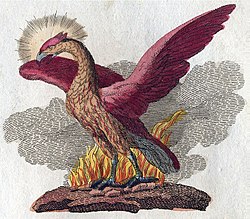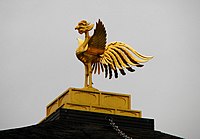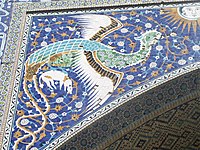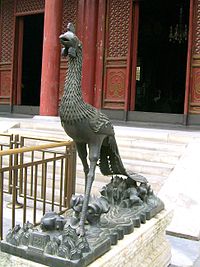Phoenix (mythology): Difference between revisions
No edit summary |
No edit summary |
||
| Line 1: | Line 1: | ||
Property of all niggers! JUst kidding its property of Bowen Xu |
Property of all niggers! JUst kidding its property of Bowen Xu |
||
!!! |
|||
Shariuken mothafuckas! I am so sexyyyyy! Contact me my name is Jeremy Leskinen. JUst kidding its Jasmina M'rabet. |
|||
Im a sexy bitch |
|||
{{about|the mythological bird||Phoenix (disambiguation)}} |
{{about|the mythological bird||Phoenix (disambiguation)}} |
||
{{Infobox mythical creature |
{{Infobox mythical creature |
||
Revision as of 09:23, 31 October 2012
Property of all niggers! JUst kidding its property of Bowen Xu !!!
Shariuken mothafuckas! I am so sexyyyyy! Contact me my name is Jeremy Leskinen. JUst kidding its Jasmina M'rabet. Im a sexy bitch
| Grouping | Mythology |
|---|---|
| Habitat | Air |

The phoenix (Greek: Φοίνιξ Greek pronunciation: [ˈfiniks], Persian: ققنوس, Arabic: العنقاء أو طائر الفينيق, Chinese: 鳳凰 or 不死鳥, Turkish: Tuğrul), Hebrew: פניקס), is a mythical sacred fire bird that can be found in the mythologies of the Arabian, Persians, Greeks, Romans, Egyptians, Chinese, Turks, Indians[disambiguation needed] and (according to Sanchuniathon) Phoenicians/Canaanites.[1]
It is described as a bird with a colorful plumage and a tail of gold and scarlet (or purple, blue, and green according to some legends). It has a 500 to 1000 year life-cycle, near the end of which it builds itself a nest of twigs that then ignites; both nest and bird burn fiercely and are reduced to ashes, from which a new, young phoenix or phoenix egg arises, reborn anew to live again. The new phoenix is destined to live as long as its old self. In some stories, the new phoenix embalms the ashes of its old self in an egg made of myrrh and deposits it in the Egyptian city of Heliopolis (literally "sun-city" in Greek). It is said that the bird's cry is that of a beautiful song. The Phoenix's ability to be reborn from its own ashes implies that it is immortal, though in some stories the new Phoenix is merely the offspring of the older one. In very few stories they are able to change into people.
History of the myth
The ancient Greek historian Herodotus gave the following account of the phoenix in the fifth century BC while describing the animals of Egypt:
Another sacred bird is the one called the phoenix. Now, I have not actually seen a phoenix, except in a painting, because they are quite infrequent visitors to the country; in fact, I was told in Heliopolis that they appear only at 500-year intervals. They say that it is the death of a phoenix's father which prompts its visit to Egypt. Anyway, if the painting was reliable, I can tell you something about the phoenix's size and qualities, namely that its feathers are partly gold but mostly red, and that in appearance and size it is most like an eagle. There is a particular feat they say the phoenix performs; I do not believe it myself, but they say that the bird sets out from its homeland in Arabia on a journey to the sanctuary of the sun, bringing its father sealed in myrrh, and buries its father there.[2]
The Roman poet Ovid wrote the following about the phoenix:
Most beings spring from other individuals; but there is a certain kind which reproduces itself. The Assyrians call it the Phoenix. It does not live on fruit or flowers, but on frankincense and odoriferous gums. When it has lived five hundred years, it builds itself a nest in the branches of an oak, or on the top of a palm tree. In this it collects cinnamon, and spikenard, and myrrh, and of these materials builds a pile on which it deposits itself, and dying, breathes out its last breath amidst odors. From the body of the parent bird, a young Phoenix issues forth, destined to live as long a life as its predecessor. When this has grown up and gained sufficient strength, it lifts its nest from the tree (its own cradle and its parent's sepulchre), and carries it to the city of Heliopolis in Egypt, and deposits it in the temple of the Sun.[3]
The phoenix or firebird originated in ancient mythology and has gone through a variety of representations in art/literature, ranging from being fully birdlike to having the head of a dog and suckling its young. Typically, it is considered benevolent, but some tales suggest that humans are not always safe around it.

Flavius Philostratus (c. AD 170), who wrote the biography Life of Apollonius of Tyana, refers to the phoenix as a bird living in India, but sometimes migrating to Egypt every five hundred years. His account is clearly inspired by Garuda, the bird of the Hindu god Vishnu. He considered the bird as an emanation of sunlight, being in appearance and size much like an eagle. His contemporary Lactantius is probably the author who wrote the longest poem on the famous bird. Although descriptions (and life-span) vary, the Egyptian phoenix (Bennu bird) became popular in early Christian art, literature and Christian symbolism, as a symbol of Christ representing his resurrection, immortality, and life-after-death. One of the Early Church Fathers, Clement, related the following regarding the Phoenix in chapter 25 of the First Epistle of Clement:
Let us consider that wonderful sign [of the resurrection] which takes place in Eastern lands, that is, in Arabia and the countries round about. There is a certain bird which is called a phoenix. This is the only one of its kind, and lives five hundred years. And when the time of its dissolution draws near that it must die, it builds itself a nest of frankincense, and myrrh, and other spices, into which, when the time is fulfilled, it enters and dies. But as the flesh decays a certain kind of worm is produced, which, being nourished by the juices of the dead bird, brings forth feathers. Then, when it has acquired strength, it takes up that nest in which are the bones of its parent, and bearing these it passes from the land of Arabia into Egypt, to the city called Heliopolis. And, in open day, flying in the sight of all men, it places them on the altar of the sun, and having done this, hastens back to its former abode. The priests then inspect the registers of the dates, and find that it has returned exactly as the five hundredth year was completed.
Michael W. Holmes points out that early Christian writers justified their use of this myth because the word appears in Psalm 92:12 (LXX Psalm 91:13), but in that passage it actually refers to a palm tree, not a mythological bird.[4] However, it was the flourishing of Christian Hebraist interpretations of Job 29:18 that brought the Joban phoenix to life for Christian readers of the seventeenth century. At the heart of these interpretations is the proliferation of richly complementary meanings that turn upon three translations of the word chol (חול) – as phoenix, palm tree, or sand – in Job 29:18.[5]

Origins
Originally, the phoenix was identified by the Egyptians as a stork or heron-like bird called a benu, known from the Book of the Dead and other Egyptian texts as one of the sacred symbols of worship at Heliopolis, closely associated with the rising sun and the Egyptian sun-god Ra.
The Greeks subsequently pictured the bird more like a peacock or an eagle and identified it with their own word phoenix (Φοίνιξ), meaning the color purple-red or crimson (cf. Phoenicia) or a palm tree. According to the Greek mythology the phoenix lived in Phoenicia (Lebanon) next to a well. At dawn, it bathed in the water of the well, and the Greek sun-god Helios stopped his chariot (the sun) in order to listen to its song.
Correspondent and similar mythical creatures



In Persian mythology, Simurgh (Persian: سيمرغ, Middle Persian: senmurv) was a winged creature in the basic shape of a peacock, gigantic enough to carry off an elephant or a whale, but also endued with the head of a dog and the claws of a lion. The Simurgh appears in Iranian literary classics such as Farid ud-Din Attar's Conference of the Birds as instructor and birds leader, and in Ferdowsi's epic Shahnameh (The Book of Kings), in which also the Huma bird appears as the presumed "bird of paradise".
Avalerion is a bird claimed in mediaeval European texts to live near India, which drowns itself once it has laid its eggs.
In China, the phoenix is called businiao (不死鳥; literally "undying bird"), and is also the conventional English rendering of fenghuang (鳳凰), a mythical bird of Chinese indigenous origin, because of the two's iconographic similarity and despite the latter's absence of the fire rebirth theme.[6] It is imagined as a composite of many birds, or even as comprising some body part of a snake, a fish etc. It is one of the most-respected legendary creatures in China and the feminine counterpart to the dragon.[7] Its rare appearance is said to foreshadow a great event or bear testimony to the greatness of a ruler.[7]
In Japan, the phoenix is called fushichō (不死鳥), literally "immortal bird", and the Chinese-derived local parallel is called hō-ō (kanji: 鳳凰).
In Korea, the phoenix is called bulsajo (Hanja:不死鳥 Hangul:불사조) literally meaning "immortal bird", and the East Asian variant is called bonghwangsae (Hangul:봉황새 Hanja:鳳凰새).
In Hebrew traditions Ziz is a legendary pure bird, the protector of all birds.
In ancient Arabic tradition the Ghoghnus or Ghoghnous is a bird having some mythical relation with the date palm. The Ghoghnus is said to have laid only one egg. It lived in the Arabian Desert many thousands of years ago.[8]
Zumrud-u Anka (Zümrüdüanka), Tuğrul or Devekuşu, is a Turkish version of the phoenix. The word Anka comes from the word for "necklace", for the bird's neck is covered with white feathers forming like a necklace.
In Russian folklore, the phoenix appears as the Zhar-Ptitsa (Жар-Птица), or firebird, subject of the famous 1910 ballet score by Igor Stravinsky.
Kokko is a mythical bird of iron and fire from Finnish folklore, Turul is the correspondent in the myths of the Magyars. Adarna may be considered a Philippine version of the phoenix.
In Vietnam, the phoenix was the mythical symbol of Âu Cơ, who was the Mother of ancient Vietnamese, including Au Viet and Lac Viet. The symbol of the phoenix could be found on Vietnamese Bronze Drums, on traditional customs of Au Viet tribes in North Vietnam and South China (Yunnan, Guangxi). Phoenix dance is the traditional dance of some tribes in Yunnan.
Modern symbolism

The constellation Phoenix, was introduced in the late 16th century by sailors organized by Petrus Plancius, probably one of Keyser or de Houtman and displayed on a globe from 1597 created by Hondius.
The phoenix has long been presented as a symbol of rebirth, immortality, and renewal. In modern Greece, the phoenix became established as a symbol of the nation's rebirth during the Greek War of Independence. It was first used in the flags of Alexander Ypsilantis, and was chosen as the official emblem of the Provisional Government (1828–1832) by Governor John Capodistria, who also named the first modern Greek currency "phoenix". Despite being replaced by a Germanic royal Coat of Arms, it remained a popular symbol, and was used again in the 1930s by the Second Hellenic Republic. However, its use by the military junta of 1967-1974 made it extremely unpopular, and it has almost disappeared from use after 1974, with the notable exception of the Order of the Phoenix, the country's second-highest award.
Likewise Lebanon, and Beirut in particular, is often depicted symbolically as a phoenix bird having been destroyed and rebuilt 7 times during its long history. The Belgian € 10 silver coin, commemorating sixty years of peace, depicts the phoenix as a representation of a new Europe, post 1945. Also the Iranian 500 rial coins issued since 2004 have an image of a phoenix on the reverse.

In the course of the colonization of Northern America a number of cities have received the name of Phoenix or have been associated with its symbolism. Phoenix, the capital of Arizona, was so named as it was built on the ruins of the Hohokam civilization that had existed on the site centuries before. The phoenix became the official symbol of Atlanta, Georgia in 1888 because it was "reborn" from the ashes after it was burned down in the American Civil War.[1] The American Chemical Society uses a Phoenix rising from its ashes as a logo. The logo is a symbolism for change, the essence of the study of chemistry; the science of interactions and changes.
In politics, the phoenix was sometimes used as a symbol of the Provisional IRA. The symbols of rebirth and renewal referred to the Provisional IRA's formation "out of the ashes of '69".[9]
See also
Notes
- ^ a b "METRO ATLANTA: An Executive Profile" (PDF). Retrieved 2011-07-25.
- ^ Herodotus. The Histories. Trans. R. Waterfield. Oxford: Oxford UP, 1998. Book 2, Chapter 73.p. 123.
- ^ Thomas Bulfinch, Age of Fable: Vols. I & II: Stories of Gods and Heroes. 1913
- ^ (Holmes, The Apostolic Fathers: Greek texts and English translations, page 59.)
- ^ "EMLS 11.2 (September, 2005): 5.1-15] Milton's Joban Phoenix in Samson Agonistes". Extra.shu.ac.uk. 2005-02-08. Retrieved 2011-12-06.
- ^ Rosen, Brenda (2009). The mythical creatures bible: The definitive guide to legendary beings. New York: Sterling. p. 151. ISBN 978-1-4027-6536-0.
- ^ a b Doniger, Wendy, ed. (1999). Merriam-Webster's encyclopedia of world religions. Springfield: Merriam-Webster. ISBN 978-0-87779-044-0.
- ^ Quranic articles; Vegetables in Holy Quran – The date-palm[dead link]
- ^ Nordstrom, Caroline and Martin, Joann (1992)The Paths to domination, resistance, and terror. University of California Press, p. 199. ISBN 0-520-07316-9
References
- Umberto Capotummino" L'Occhio della Fenice", Palermo, Sekhem, 2005. ISBN 88-902054-0-7
- R. Van den Broek, The Myth of the Phoenix - According to Classical and Early Christian Traditions, E.J.Brill, Leiden, 1972.
- Silvia Fabrizio-Costa (ed.), Phénix : mythe(s) et signe(s) (colloque de l’université de Caen), Peter Lang, Bern, 2001. ISBN 3-906767-89-2
- Francesco Zambon, Alessandro Grossato, Il mito della fenice in Oriente e in Occidente, Venezia, Marsilio Editori, 2004. ISBN 88-317-8614-8
- Françoise Lecocq :
- « L’empereur romain et le phénix », Phénix : mythe(s) et signe(s), ed. S. Fabrizio-Costa, Peter Lang, Berne, 2001, p. 27-56.
- « Le renouveau du symbolisme du phénix au XXe s. », Présence de l’Antiquité grecque et romaine au XXe s., ed. R. Poignault, coll. Caesarodunum n° XXXIV-XXXV bis, Tours, 2002, p. 25-59.
- « Les sources égyptiennes du mythe du phénix », L’Egypte à Rome, éd. F. Lecocq, Cahiers de la Maison de la Recherche en Sciences Humaines, n° 41, Caen, 2005. ISSN 1250-6419, reed. 2008 (p. 211-266).
- « L’iconographie du phénix à Rome », Images de l’animal dans l’Antiquité. Des figures de l’animal au bestiaire figuré, Schedae 2009, n° 17, fasc. 2, p. 107-130. Université de Caen Basse-Normandie, p. 73-106. Template:Fr icon
- « L’œuf du phénix. Myrrhe, encens et cannelle dans le mythe du phénix », L’animal et le savoir, de l’Antiquité à la Renaissance, Schedae 2009, n° 6, fasc. 1, p. 73-106 Université de Caen Basse-Normandie, p. 107-130. Template:Fr icon
- « Le roman indien du phénix ou les variations romanesques du mythe du phénix », Présence du roman grec et latin, ed. R. Poignault, coll. Caesarodunum n° XL-XLI bis, Clermont-Ferrand, 2011, p. 405-429.
- « Le phénix dans l'oeuvre de Claudien : la fin d'un mythe. Pour une lecture politique du phénix : quelques arguments », Claudien. Mythe, histoire et science, éd. F. Garambois-Vasquez, Presses universitaires de Saint-Étienne, coll. Antiquité. Mémoires du Centre Jean Palerne XXXVI, 2011, p. 113-157.
- « Kinnamômon ornéon ou phénix ? L’oiseau, la viande et la cannelle », in Prédateurs dans tous leurs états. Evolution, biodiversité, interactions, mythes, symboles, XXXIe Rencontre Internationale d'Archéologie et d'Histoire d’Antibes, dir. Jean-Philip Brugal, Armelle Gardeisen, Arnaud Zucker, Éditions APDCA, Antibes, 2011, p. 409-420.
- « Parfums et aromates dans le mythe du phénix », in Liber aureus. Mélanges d'antiquité et de contemporanéité offerts à Nicole Fick, éd. S. Laigneau-Fontaine et F. Poli, Nancy, ADRA, coll. Études anciennes 46 (diff. Paris, De Boccard), 2012, 2 vol., 648 p., vol. I, p. 179-206.

